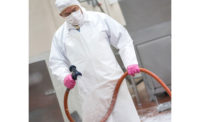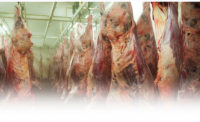Processing | Conveyors & Beltings
Keeping product rolling along safely
Sanitizing conveyors and belts efficiently is essential for food safety, reduced operating expenses.

Managing conveyors and belting in meat and poultry plants can be a complicated business.
For optimal performance, processors must leverage equipment that not only is durable and reliable, but has features that help save energy and can support increasingly faster processing rates.
It also is crucial for plant operators to have solid cleaning and sanitizing procedures to keep conveyors and belting free of the microbials that can cause product spoilage, waste, shorter shelf life and foodborne illness. This equipment also must be designed so it can be easily cleaned and won’t harbor pathogens.
“Proper sanitation must be a plant- and companywide concern every day,” says Robert Delmore, a professor in the Department of Animal Sciences at Colorado State University, in Fort Collins. “When this falls off the radar and becomes an afterthought, problems are sure to follow.”
Measures that compromise food safety include misjudgments on how long cleaning agents should remain on equipment before washdowns, and a failure by personnel to temporarily remove specific machine parts in order to effectively sanitize all equipment areas, says Kristi Koschmann, safety consultant with Allen Safety, a Merritt Island, Fla.-based global safety and process improvement company. “Workers must be able to access conveyors and belts completely and in a timely manner,” she says. “This can be difficult when the equipment is enclosed.”
In addition, processors must develop the most effective sanitizing methods for their specific operations, which could include choosing between manual and automated cleanings for specific equipment and utilizing the optimal cleaning compounds.
Manual cleanings are more time consuming and potentially hazardous to workers because of the greater human interaction with machinery, Koschmann says. The potential for over spraying and recontaminating surfaces also persists, while plant operators also must contend with labor shortages, training issues and the time-consuming dismantling of equipment for sanitizing, she notes.
Automated cleaning systems are faster and more likely to ensure uniform and systematic sanitizing, Koschmann says. She says, however, that while automation is predictable and consistent, it “lacks human judgment, adaptability and logic. Sanitation workers can respond to varying conditions of a task while clean-in-place systems cannot.” Clean-in-place (CIP) is a procedure of cleaning interior product contact surfaces such as process pipes, vessels and equipment without disassembly or manual involvement.
Automation is not the only answer
Nevertheless, automated washing systems, are becoming more prevalent by providing processors with greater operating efficiencies and less production downtime and labor use, while helping to save on water, chemicals and energy, she says. In addition, automated systems can clean machinery without requiring all processing operations to shut down, Koschmann says, adding that CIP is more likely to ensure a faster, uniform and systematic cleaning while giving operators more command over the sanitation process.
“Because there is less control with manual sanitizing, mistakes can happen,” she says. “A sanitation worker may apply more water than is necessary while cleaning, whereas a CIP system will use precise amounts every time and chemical dilution also is more accurate.”
Because CIP systems add additional piping and pipe threads where bacteria can grow, some processors are emphasizing manual sanitation and limiting CIP to equipment that workers cannot easily access, such as overhead conveyors, she says.
Conveyor and belting manufacturers, meanwhile, are increasingly upgrading equipment to enhance food safety, says Norman Marriott, emeritus professor in the College of Agriculture and Life Sciences at Virginia Polytechnic Institute and State University (Virginia Tech), in Blacksburg. That includes reducing elements that are likely to harbor microbials while incorporating more cleaning-friendly designs, such as rounded instead of sharp corners, easier-to-sanitize stainless steel and fewer nooks and crannies, he says.
That is important because insufficient belt cleaning can result in damage and slippage and cause the belts to misalign, get off track and undergo uneven wear, which makes the entire system work harder, use excess energy and eventually cause costly line interruptions and the failure to meet food safety requirements and expectations, Koschmann says.
Processors also face sanitizing challenges when using belts with interlocking designs or metal mesh as the equipment often contains linkages, crevices and grooves which enable bacteria to more easily hide and accumulate, she says, adding that not maintaining conveyor belts can foster the cracks and tears that also attract pathogens. Rust, corrosion and metal flakes from metal on metal machine contact, meanwhile, can create additional contamination threats, Koschmann says.
A variety of sanitizing variables
Using the optimal cleaning solutions at the appropriate periods is the most effective way to eradicate microbials, Marriott says. That includes leveraging the quaternary ammonium compound, also known as quats, which has a longer residual effect and is effective against most pathogens, including Listeria monocytogenes, Marriott says. But because it is ineffective against gram-negative spoilage bacteria, such as Pseudomonas, a germ commonly found in soil, water and plants, processors should use quats in conjunction with acid or chlorine selections that have a broader range, he says.
“Chlorine sanitizers are less expensive and operate very quickly by destroying microorganisms within 60 seconds,” Marriott says. “But chlorine dissipates more rapidly so there are no residual qualities. Quats will be effective for a much longer period.”
While residual effectiveness for sanitizers will vary in accordance with temperature, air movement and ambient contaminants, chlorine solutions are often functional for just few minutes while quats might be potent for many hours, Marriott says. He suggests processors use chlorine sanitizers on conveyors and belting for weekday cleanings and longer-lasting quats over the weekend when plants are not operating and there is less need for chlorine options.
By regularly rotating sanitizing compounds, processors also will better prevent pathogens from developing resistance to specific cleaning solutions, Marriott says, while helping to prevent the formation of biofilms, a thin, slimy film of bacteria that adheres to surfaces. “Biofilm occurs from inadequate cleaning and sanitizing and protects the microorganisms from destruction,” he says. “It is much more difficult to remove microorganisms once biofilm forms on equipment.
Don’t deviate from the directions
For the greatest impact, cleaning personnel should follow a two-step process that involves the use of detergents and then sanitizers, Delmore says. He notes, however, that processors often compromise performance by not adhering to usage guidelines.
“Most operators know of the need to rinse, foam, scrub, rinse and sanitize, but time and challenges sometimes result in more rinsing the physical scrubbing,” he says. “Some processors also use conveyor belts that are in suspect condition longer then they should. Having to deal with cuts, grooves and broken pieces of conveyor make the sanitation process more difficult.”
He adds that poor equipment design, substandard plant layouts and deficient maintenance procedures can keep processors from accessing all parts of the machine for sanitizing. That includes a lack of proper spacing between equipment and plant walls, and the inability to easily lift belts and treat the underside of conveyors, he says. Delmore says it also is critical for processors to keep sanitation issues in mind when making modifications or repairs to machinery so as not to create new vulnerabilities.
Keep close watch on the workers
To help ensure plant workers follow the proper sanitizing procedures, it is important for operators to hire people who are capable and conscientious then properly train and supervise them, Marriott says. Cleaning and sanitizing product suppliers will typically provide operational guidelines and some also train employees on product use, he says.
Delmore adds that operators also need to audit workers’ actions “to confirm they are following the sanitation standard operating procedures to the letter.”
In addition, processors should scrutinize worker safety as cleaning conveyors and belting can be hazardous, Koschmann says. This is particularly true when employees use elevated platforms to sanitize overhead or hard-to-reach equipment. Such activities typically demand the use of fall-protection equipment, including guarded platforms, ladders, scaffolding, aerial lifts and harnesses that anchor to specific points to protect against mishaps.
The use of lock out/tag out measures on machinery to ensure equipment cannot accidentally run while a worker is in harm’s way also is important, Koschmann says. “The ability to isolate individual conveyors helps ensure the sanitation teams’ safety while cleaning equipment,” she says.
Meat and poultry processors that lack a consistent and effective sanitizing program also risk such consequences as downtime and higher equipment repair costs, she says. “But the more serious outcome is the possibility that there will be production contamination, resulting in health concerns for consumers,” Koschmann says. NP
Looking for a reprint of this article?
From high-res PDFs to custom plaques, order your copy today!









